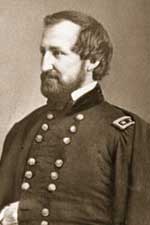| PART 3 |
|
|||||
|
Major General William Starke Rosecrans |
||||||
|
Cincinnati, Ohio |
||||||
|
The Wheel of Life Makes Interesting Turns |
||||||
 |
I do not think the choice of Cincinnati for Rosecrans' next career was a random selection. Eliakim Parker Scammon graduated from West Point in 1837 and stayed on as a professor of mathematics. He may have taught Rosecrans and would surly have been impressed by a self taught mathematician. Rosecrans probably worked under Scammon when he was "Cadet Professor" of Mathematics. Scammon was one of the first appointed to the Corps of Engineers - Rosecrans was also appointed. |
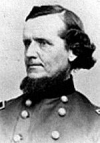 |
||||
|
William S. Rosecrans |
Eliakin P. Scammon |
|||||
|
The two men continued to turn in the same direction. Scammon converted to Roman Catholicism in 1846 (was he also a Rosecrans convert?). After his military career, he retired in 1854 to teach math in Mount St. Mary’s College in Cincinnati. To add another spoke to the wheel, Father Sylvester Rosecrans (William’s brother) was ordained in Rome in 1852 and after touring through Italy, France, England, and Ireland, Father Rosecrans was sent to the Archdiocese of Cincinnati and was appointed pastor of St. Thomas Church. He was then assigned as a curate at St. Peter in Chains Cathedral and a professor at Mount St. Mary's Seminary of the West. He became president of the college in 1856. It is likely the William came to be near his brother and Scammon to be near William. |
||||||
|
However it happened, Father Sylvester and Eliakim were teaching at Mount St. Mary's. Following Chickamauga, William's family was living next door to the seminary in a stone house, called "Roccabella", which had been the convent. It had a very pretty old fashioned garden and a large grape arbor, a raspberry patch and numerous walks with roses, hollyhocks, marigolds and lilies. |
||||||
|
Mt. St. Mary's on Price Hill |
||||||
| A quiet lane ran by the house with another road led about a quarter of a mile to Mt. St Mary's Seminary where Sylvester was president. | ||||||
 |
Price Hill Historical Society says the home at
2935 Lehman Road in Price Hill
is where General Rosecrans stayed. Is this Roccabella? Let the wheel spin and return to the Rosecrans story - - - - |
|||||
|
Architect, Consulting Engineer |
||||||
| Twenty days after leaving the army, a new daughter, Lily Elizabeth, joined the family in Cincinnati on the 21 of April 1854. | ||||||
|
Although still not recovered from exhaustion, William worked as an architect and consulting engineer until June 1855 when an agent from Cannel River Coal Company, an English and American company, invited him to take charge of the company's mining interests on Coal River, Kanawha County, Virginia. The known seams had been mined out |
||||||
|
and the company wanted to know if there was more there. Fitch says William examined the existing mines and reported on their condition. Then he made a geological survey of the country and did a series of scientific explorations so he was able to point out with marvelous certainty the localities where new and profitable coal deposits could be opened. He submitted the result of the survey and plans for development to the company. Transporting the coal from the mines was a problem. Rosecrans and William Madison Peyton designed a series of locks (actually log and beam sluices) on the Kanawha River to transport the coal. In 1856 Rosecrans was made president of the Coal River Slack-Water Navigation Company. A flood washed the locks out and they had to be rebuilt. By the second time they were flooded out petroleum products had Rosecrans attention. At least some of this time the family lived in Wheeling where Anna Dolores (sometimes called Anita) was born. The New Coal River-Slack Water Navigation Company hired a practical engineer to
devise plans for making coal oil. The results were positive
for making the coal oil but it required a large outlay of money to
start so the company decided not to go that route. |
||||||
|
Rosecrans decided to engage in the business himself. In 1857 he organized the Preston Coal Company for that purpose. With a partner who claimed to know how to make coal oil, Rosecrans began erecting a structure. Before it was done, he met two others interested in buying into the business. They expanded it so they would be able to make 500 gallons a day. It was obvious the first man did not know how to make the coal oil so Rosecrans began his own experiments. In Cincinnati's 1858 Williams Directory, the Rosecrans family lived at 385 George Street and he is listed as a coal manufacturer. He is the only manufacturer of coal oil in the Directory and his business was at 423 W. 2nd Street. |
||||||
|
|
||||||
|
Unfortunately kerosene was not a stable compound and fires frequently were the result of using it. William was determined to perfect the product so it would be safe. For 16 days he worked on developing pure and odorless oil. When he was about to succeed in his efforts, one of the ‘safety’ glass lamps he purchased exploded and badly burned him. After putting out the fire, William walked home to 385 George Street and spent the next 18 months in bed recovering. The explosion left him scarred on the right side of his face so photographs show him turned so the scars do not show. As soon as he was able, he returned to his business. Although his partners were honorable men they were not chemists, so the business was not successful. William worked hard to get it in good working order. Fitch says Rosecrans believes he was the first to obtain a good article of odorless oil from petroleum, Directing his efforts to the chemical composition of soaps, he made some valuable discoveries, among which was finding of a cheap and sure process of manufacturing a soap with chlorine properties. He experimented in the construction of lamps and with the shape of wicks, developing a round tightly woven wick which burned longer and with less smoke than earlier wicks. He invented a lamp which could successfully use a shorter chimney. |
||||||
|
|
||||||
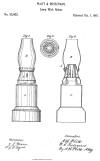 |
Two of the few patents issued to Rosecrans came through at the onset of the war. However the inventions were made before and the Patents applied for before the war. Anson H. Platt and William S. Rosecrans got Patent #33402 for an Lamp Wick Raiser which improved oil lamps issued on October 1, 1861. On the same date they got Patent #33,403 issued on October 1, 1861, for An Improved Scale and Weighing Apparatus. Ann E. Rosecrans witnessed both patent applications. |
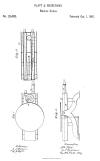 |
||||
|
Rosecrans went to war and Anson H. Platt moved to Yellow
Springs, Ohio, where he got three other Patents. |
||||||
|
An article in The Engineer, published
November 21, 1862,
contained an article about the lamp invention headed
Invention
of Anson Platt and General William Rosecrans |
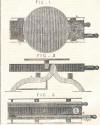 |
|||||
|
During this time the national scene was heating up with threats of secession from the southern states. Like his father before him, William began to train the local home militia. He organized and drilled the Marion Rifles which was the Company from the 14th ward in Cincinnati. In 1861, son Carl Frederick was born in Cincinnati. |
||||||
| Return
to
Rosecrans, Part 1,
Genealogy and Youth Return to Rosecrans, Part 2, West Point, Marriage, Engineers Corps Return to Rosecrans, Part 3, Civilian Inventor, Engineer Return to Rosecrans, Part 4, Civil War Return to Rosecrans Part 5, Post Civil War Civilian Goto
Rosecrans Part 6: Equestrian Statue of |
||||||
Site Navigation Guide: The source is blue, learn more is in italics Click on photos to enlarge. Use BACK to return to this page © by Polly Horn for Big Walnut Area Historical Society |
(05/19/2015 |
|||||
